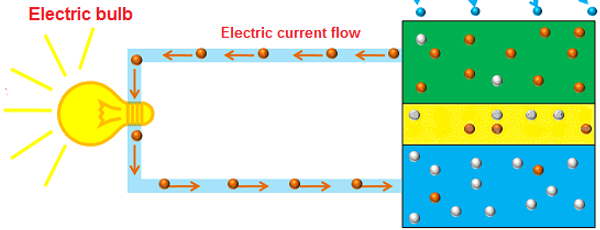In this article, we will describe a process of getting solar energy from the sun so that even if you are studying at school you will get a basic view of how solar panels work. We will be short and precise.

Structure of solar panels
Standard solar panels consist of 60 to 96 solar cells. The size depends on the customer’s needs.
The structure of solar panels has 7 layers:
- Aluminum Frame: The aluminum frame provides structural support to the solar panel, protecting it from physical impacts and environmental elements. It also helps in mounting the panel securely onto constructions.
- Tempered Glass: The tempered glass layer covers the front of the solar panel, offering protection against weather conditions like hail, rain, and wind while allowing sunlight to pass through. It is strong and highly durable to resist breakage.
- Encapsulant – EVA (Ethylene Vinyl Acetate): EVA encapsulant layers are placed above and below the solar cells to bind them together and protect them from moisture, dust, and mechanical damage. The encapsulant also helps increase the optical efficiency by reducing reflection.
- Solar Cells: Solar cells are the core components that convert sunlight into electricity. They are usually made of silicon and are arranged in a grid pattern within the panel.
- Back Sheet: The back sheet is the bottom layer of the solar panel that provides insulation and protection against environmental factors like moisture and UV radiation. It also ensures electrical insulation and contributes to the panel’s durability.
- Junction Box: The junction box is attached to the back of the solar panel and houses the electrical connections. It often includes bypass diodes to protect the panel from damage due to shading or other electrical issues, and it facilitates the safe and efficient transfer of electricity generated by the solar cells.

How do solar panels work?

Everyone nowadays knows that people can receive energy from the sun with the help of solar panels. But let us dive a bit further to get a better view of it. We will divide the picture from above into smaller parts and then we will be combining them one with another to get a full picture.
Solar cell itself consist of a semiconductive material, typically silicon. For those of you who didn’t know, a semiconductor is a type of material that normally doesn’t conduct electricity well, but it can, however, under certain conditions. The semiconductor part of the solar cell has three layers.
The top layer of the solar cell contains silicon and some amount of an element, such as phosphorus, that has more electrons than silicon (silicon has 14 electrons and phosphorus has 15 electrons). With this in place the top layer has free to move electrons and the material becomes more conductive. Meaning, that the sum of phosphorus’s 15 electrons and the silicon’s 14 electrons would be more than the sum of silicon and boron in the bottom or P-type layer (14+15=29 electrons) The top layer is also called negative-type, or N-type, as it favors the collection and transport of electrons.

The bottom layer contains both silicon and an element, such as boron, that has fewer electrons than silicon (silicon has 14 electrons and boron has 5 electrons). Compared to the N=type layer, the bottom layer has fewer electrons that are free to move, therefore making the material less conductive for electrons (14+5=19 electrons which is fewer than the sum of electrons in N-type). A missing electron can be described as an effective positive charge. Therefore, the bottom layer is called positive-type, or P-type, as it preferentially favors the collection and transport of these positive charges, also named as ‘holes’.

Moving towards the middle layer which has only slightly fewer electrons, making it marginally P-type.

So, how electricity is generated from solar panels? When light waves hit the top surface of the silicon solar cell, it is absorbed into the middle layer of the solar cell. Not all the types of sun waves can be absorbed by the solar panel.

The light wave knocks an electron off a silicon atom, setting the electron loose and leaving an area of positive charge (a ‘hole’) where the electron used to be. The loose electron then climbs up and reaches the top N-type layer, which gladly accepts electrons. Similarly, the loose hole gets down and reaches the bottom P-type layer, which gladly accepts holes. This continues throughout the sun shining on the solar cell.

Now that the electrons and the holes have been separated, connecting a wire between the top and the bottom metal electrodes provides a pathway for the electrons to move toward the holes. So in the end we get an electrical current.

How much electricity do solar panels generate?

One solar cell produces several Watts of power. This may be sufficient for running a small electric bulb, or a phone charger, but it is not sufficient for running a kettle, for example, which uses more than one thousand Watts. So, several solar cells, typically 62, are wired together to make a solar panel. Several solar panels are needed to generate enough electricity to power a household.
Of course, solar cells produce electricity only during the day, so, storing the electricity efficiently for use during nighttime is another important challenge. Advancements in solar technologies present the potential to power our lives if we just leave it to the sun!